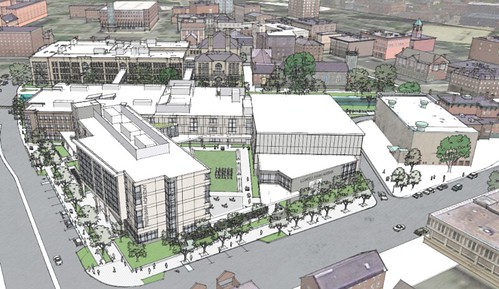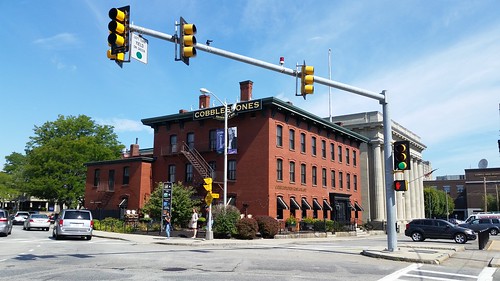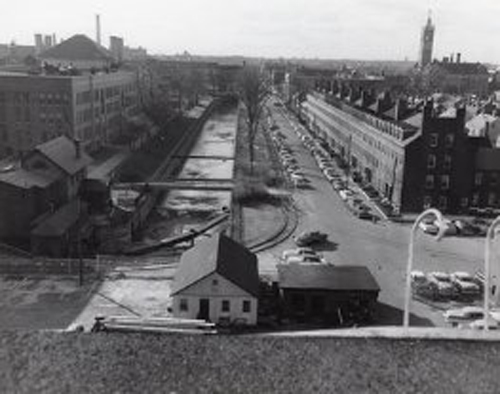Lowell Week in Review: February 16, 2019

Artist rendering of new Lowell High, viewed from above Tsongas Arena. Masonic Lodge and Cobblestones are to the right.
Lowell High Plan Advances
On Tuesday the City Council voted 8 to 0 to send the schematic design of the new/renovated Lowell High School to the Massachusetts School Building Authority (Mayor Samaras missed the meeting due to a medical issue).
Of particular note was the vote of Rita Mercier, who has steadfastly opposed any plan that would take the “dentists’ office” at 75 Arcand Drive. Councilor Mercier did vote in favor of this plan (which included the taking of that property), but before making that vote, she gave a gracious explanation that she had fought the fight but the issue had been decided against her (and the dentists), so now it is time to come together and do everything we can to ensure that the children of Lowell get the best high school we can afford in the downtown location.
While the council may have unified behind this project, not everyone else has. The “I told you so” chorus remains vocal in criticizing the downtown plan even before the first shovel goes into the ground. The council will undoubtedly have some tense moments, particularly over cost, but it’s a good sign that our elected official all seem to be working together for a successful outcome.

Cobblestones with Masonic Temple in background. Extension of Dutton St runs in front of restaurant
Cobblestones
Olivers? Wasn’t the name of the restaurant the preceded Cobblestones into the three story red brick building at the corner of Dutton and Merrimack streets? That the names of that restaurant and at least one or two others that preceded Cobblestones into that space are testament to the current occupant’s longevity, great service and excellent food. Originally built in 1860 as an upscale boarding house for supervisors at the Merrimack Manufacturing Company, the building is best known as the home of the Yorick Club, a private men’s club that occupied the space from 1901 until 1979. A couple of restaurants opened in the space for short, unsuccessful runs and then the building sat vacant until Cobblestones opened in 1994.
At Tuesday night’s council meeting, the general manager of Cobblestones addressed councilors and shared a couple of concerns of the business, namely the reduction of parking available to the restaurant and the transformation of the nub of Dutton Street that runs in front of the restaurant into a possible vehicular entrance to the high school complex. The handful of parking spaces on that portion of Dutton Street are used by customers and the parking lot of the dentist’s office was available to Cobblestones customers in the evening.

Dutton St in 1960s or earlier. LHS 1922 building to left; LHS 1980 building replaced this portion of Dutton St and adjacent worker housing
Councilors were quite clear in their willingness to support Cobblestones as was City Manager Eileen Donoghue who told councilors that members of her administration have been meeting with the owners of the restaurant to find ways to mitigate any disruptions caused by the high school project.
Brian Meade Jr, a Lowell resident who has some well-formed ideas about making downtown Lowell more pedestrian friendly and who frequently shares his thoughts on Twitter, left a comment yesterday on my Tuesday city council post that addressed the concerns of Cobblestones. Brian’s observations are worth repeating here in their entirety:
The problem with Cobblestones isn’t LHS but inhospitable walkability around Ladd Whitney Sq and Dutton St in general. If you look at 1960-1970’s photos Dutton St had metered parking throughout and Ladd Whitney Sq had an additional traffic island on Arcand Dr used for parking and as a safe harbor for pedestrians.
Allowing on-street parking on all of Dutton St and Arcand Dr would make up for any lost parking at the Dental office. It would create a barrier of steel separating the sidewalk from speeding cars. It would improve the outside dining experience at Cobblestones and knit back together upper and lower Merrimack St.
The tradeoff would be less driving lanes. For instance reducing Dutton St to 3 lanes (with a center turn lane such as on Andover St) would make this possible.
Tre Monte, Fuse, Ramen 1981, El Potro and soon The Athenian Corner all do well without dedicated off-street parking. They are also located in on-street parking rich areas that make for great walkability.
To see what happens to restaurants and spaces that should be thriving but continuously fail look at Kearney Sq. The corner restaurant space has scant on-street parking and bad walkability. Where we prioritize traffic throughput businesses die. And yet congestion is STILL horrible.
Cobblestones is right to be worried about their future but blaming LHS is wrong. Will the city finally right a wrong decades in the making by boldly improving walkability in the area or will it continue the failed policy of trying to improve traffic flow – businesses and quality of life be damned?
Sadly I think I know the answer.
Brian is not alone in his critique of the modern manifestation of the Dutton/Merrimack Street intersection. None other than Jeff Speck, the internationally-known urban planner who has studied Lowell extensively, in his book, The Walkable City, cited that very intersection as one of the worst designed intersections for walkability that he has encountered anywhere in the world.
Perhaps the city will exercise some creative thinking in improving walkability of that entire area in conjunction with the work at the high school. As Brian suggests, why not allow curbside parking on Dutton Street? That would provide additional spaces but would also slow traffic which is key to making the area safer. Also, it seems like police officers going on duty park their personal vehicles in the parking lot of the Masonic Temple which is adjacent to Cobblestones. Does the city lease that lot for the officers? Do they have their own arrangement with the Masons? Why couldn’t the city facilitate a parking rental agreement between the Masons and Cobblestones to make up for the loss of the 75 Arcand Drive lot and find places for the private vehicles of on-duty police officers elsewhere?
And while there hasn’t been much talk recently about the redevelopment of the Smith Baker Center, I assume that project is still in the pipeline. Making it easier to get across the Dutton/Merrimack intersection on foot from the rest of downtown will be critical to the success of that project.
Blue Ribbon Committee
Wednesday night the Lowell School Committee voted to launch the search for a new school superintendent. Part of the motion called for the creation of a Blue Ribbon Screening Committee. There is a long history of such citizen committees participating in the Lowell School Superintendent process, but the power of these committees has been curtailed by school committees over the past two decades.
The reduction of the importance of these citizen committees was a direct result of the actions of the Blue Ribbon Committee appointed back in late 1999 to help select a replacement for George Tsapatsaris, one of the most successful school superintendents in Lowell history.
A few weeks ago, I wrote extensively about the history of school superintendent selections from 1969 to the present. Here’s what I wrote about the 2000 superintendent selection which resulted in the hiring of Karla Brooks-Baehr:
In the 1999 city election, voters re-elected Timothy Golden, Regina Faticanti, Kevin McHugh and Joseph Mendonca. Joining them were newcomers Connie Martin and John McQuaid. Incumbent George Kouloheras lost. Incumbent William Taupier did not run. Eileen Donoghue was elected mayor.
In August 1999, Lowell Superintendent George Tsapatsaris announced he would retire effective June 30, 2000. The School Committee convened a Blue Ribbon Panel to recommend candidates to succeed Tsapatsaris.
On April 20, 2000, the school committee elected Basan Nembirkow, the superintendent in Greenfield, Massachusetts, to be the next Lowell superintendent. Voting for Nembirkow were Mayor Eileen Donoghue and school committee members Joe Mendonca, John McQuaid, and Connie Martin. Committee members Regina Faticanti, Timothy Golden, and Kevin McHugh all voted for Lowell Deputy Superintendent for Personnel Helen Flanagan. Other candidates were Karla Brooks Baehr, Carol Kelly, Lowell High headmaster William Samaras, and Lowell Assistant Superintendent Rosemary Leblanc-Considine.
However, after meeting with the school committee in May to negotiate his contract, Nembirkow revoked his acceptance of the job, citing “internal strife” on the school committee as one of his reasons. The school committee reconvened on May 17, 2000 and unanimously selected Wellesley superintendent Karla Brooks Baehr to be the next Lowell superintendent.
What I left out of that account was the role played by that year’s Blue Ribbon Committee which consisted of about 20 people including one appointed by each school committee member and others representing various institutions connected to the Lowell Public Schools. For instance, I was the representative of the Citywide Parent Council. Don Pierson and Molly Sheehy represented UMass Lowell and Middlesex Community College respectively. The chair of the Blue Ribbon Committee was Michael Gallagher who was appointed by Mayor Eileen Donoghue.
Readers today may be shocked to learn that in 2000, there was a struggle between those who wanted a candidate from within Lowell and those who didn’t rate prior experience or residence in Lowell that high on the list of important qualities in a school superintendent. However, that division didn’t manifest itself on the Blue Ribbon Committee which was nearly unanimous in its decisions.
Here’s what the Blue Ribbon Committee did: After extensive interviews of seven or eight candidates, all televised live from the city council chamber followed a week later by a very public deliberation and report-writing process (the Lowell Sun reporter was in the room the entire time with no constraints on what could be used in print), the Blue Ribbon Committee issued a report that not only named the top three candidates, but rank ordered them. Only one “Lowell candidate” was in the top three and he was in third place. But this wasn’t just a list: there were extensive citations to what candidates had said during their interview along with explanations of why the cited comments were seen positively or negatively, all justifying the ranking arrived at by the Blue Ribbon Committee.
Because of the very public and very thorough job done by the 2000 Blue Ribbon Committee, that year’s school committee was essentially painted into a corner when it came to choosing the next school superintendent. An outsider was selected by a 4 to 3 vote but he didn’t even make it to day one and bailed out within a couple of weeks of the vote. The (chastened?) school committee then voted unanimously for Karla Brooks Baehr who went on to serve for eight very successful years.
But Dr. Baehr’s time in Lowell wasn’t free of “she’s not from here” pushback from some local interests, so while she left on her own terms, her departure came sooner than she wanted, due primarily to her feeling that her effectiveness would be too diminished by the increasing hostility she expected from the school committee that was elected in 2007.
When Dr. Baehr announced her intention to not seek another contract, that same 2007 school committee (Regina Faticanti, John Leahy, Jackie Doherty, Jim Leary, Connie Martin and David Conway with Bud Caulfield as mayor) created another Blue Ribbon Committee but greatly curtailed that group’s authority as compared to the 2000 Blue Ribbon group. For instance, among other constraints, the school committee expressly forbade the Blue Ribbon Committee from rank-ordering candidates.
In 2008, the candidate pool of outside applicants was thin. I’ve always believed that one reason for that was that Karla Brooks Baehr was held in such high esteem by her colleagues in public education around the state that when she was driven out of the job by the school committee, few people wanted to come here and meet the same disagreeable end (which is exactly what happened to Baehr’s successor, but that’s a story for another day).
So when the 2019 Blue Ribbon Committee is formed, watch closely for what constraints are placed on it by the current school committee and then judge what type of community input school committee members are interested in receiving.
Real Estate Records
Real estate accounts for trillions of dollars in value in the U.S. economy. Investors look to real estate for a safe, reliable return on their investments, whether those investments are in the form of equity or mortgage lending. And for individuals, the family home is most likely their most valuable asset.
Few people appreciate that one of the primary reasons that real estate is such a good investment is because our system of recording who owns what – our land records – works very well. Established in 1640 by the early English settlers of Massachusetts, the system of tracking ownership and transfers of ownership hasn’t changed all that much in the intervening 359 years.
A key to the success of this system is that everything is public. There is no hidden ownership. All the records are out there for public scrutiny and something that’s not in the public record loses out to something that is in the public record.
That’s why it was disappointing and bothersome to read in yesterday’s Boston Globe that the records for Massachusetts Lieutenant Governor Karyn Polito’s Shrewsbury home were removed from the online database of the Shrewsbury assessors at the request of Polito’s husband. The assessors interviewed in the story seemed surprisingly nonchalant in their apparent willingness to remove information from the public record. To be sure, the Polito records are available for public review by going to Shrewsbury town hall, but they are not online along with everyone else’s information – one type of “public information” is a lot more public than the other.
(And for those wanting to cite “security” as a reason for keeping the house records offline, if that were a legitimate rationale for keeping the records confidential, it would have been easy to have the house owned by a trust with the trustee being a lawyer or other real estate professional, so the record would have no indication of ownership by a public official yet would still be publicly available for viewing).
It is true that assessor’s records don’t equate with ownership; it’s the records of the Registry of Deeds that determine who owns what. But the assessors records are the exclusive location of public information about what is built upon the property and what kind of property taxes are generated by the parcel.
There’s an important public policy reason for having that information easily available to the public. How many of you have gotten your tax bill and thought, “That seems a bit high; I wonder what my neighbor is paying?” Well for most municipalities, including Lowell, you can go to the assessor’s webpage and find out the exact assessment of your neighbor’s property and compare it to the assessment of your property. Another target of taxpayer scrutiny is the homes of elected officials. The unfortunate cynicism of many in the American public assume elected officials are beating the system in every way possible. When the property tax records of elected officials are kept out of the public eye when everyone else’s are readily available, it just feeds that cynicism.
As always Thanks for sharing your insights Richard. They are always well informed and appreciated. Brian Meade is not wrong in his assessment of the Dutton And Merrimack Street intersection and the new traffic pattern and light configuration has made it even more dangerous for pedestrians and cars alike. We witness near accidents at that intersection daily.
One note to make, while we have heard the argument that many people make that other restaurants do well in downtown without off street parking – What is not realized is that those same restaurants are not supporting a 12,000 sqare foot historic building with three floors of restaurant and function space, along with 50 employees. A restaurant located on a very tough corner for pedestrians and walk ability as noted. The restaurants such as Fuse, tre-Monte, Ramon 1981 etc are instead, much smaller urban spaces with many fewer seats and employees. Spaces that can succeed without off street parking.
Thanks again!
Kathy
Great commentary.
I’m adding Brian Meade to my Twitter feed today. As a newer downtown resident, I think his analysis of the precarious Dutton/Merrimack intersection is dead on. Let’s hope a plan to mitigate pedestrian access and address Cobblestone’s substantial concerns is forthcoming.
Tough to ponder the School leadership chaos, but the history seems clear. A Search Committee dedicated to finding a great new superintendent should be assembled and given broad authority to do its job.